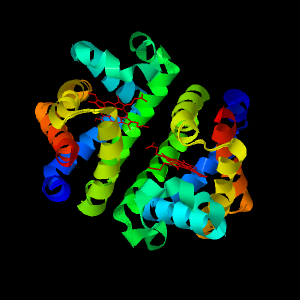Hemoglobin
Hemoglobin is an oxygen carrier that becomes saturated with oxygen in the lungs and releases that oxygen in the capillaries of tissues. Click here for a tour of the protein.
This protein is a tetramer consisting of two alpha subunits and two beta subunits. Shown here is an alpha-beta dimer.
Each subunit, almost identical to myoglobin, is composed of eight helical segments. In fact, 76% of the residues are in a helical conformation.
A cleft formed by the E and F helices (as well as numerous hydrophobic residues) holds an exposed heme group
Each heme has two negatively charged propionate groups that protrude from the pocket. Two arginine residues stabilize these negative charges.
When one heme binds an oxygen molecule conformational changes occur that enhance the oxygen binding of the other heme groups.
This is known as cooperativity. The conformational changes eventually result in the alpha-beta dimers sliding past and rotating relative to one another.
Phe 97 controls oxygen affinity and is also important in intersubunit communication as well. Phe 97 is packed tightly against the heme in the unbound molecule.
This type of packing is only possible if the iron is located significantly outside of the plane of the heme. This sterically contrains the heme.
When the ligand binds to the iron, the iron atom is brought into the heme plane (bringing with it His 101). The movement of the histidine results in the Phe 97 being extruded from the heme pocket into the dimer interface. Once Phe97 is expelled from the heme pocket, the heme settles 0.6 angstroms deeper into the subunit.
When the heme drops deeper into the subunit, it influences the conformation of two other residues on the F-helix: Lys 96 and Asp 100.
These residues link the heme with a helix on the neighboring subunit-thereby influencing the binding of the second subunit. Thus these residues are crucial for the molecule's positive cooperative effect.
For more information about hemoglobin see this site at the Protein Data Base
Prepared by Jackie Wilce, Monash University
Adapted from Charles Grisham's "Interactive Biochemistry"
Page skeleton and JavaScript generated by the Export to Web module of Jmol 14.29.5 on 05/03/2018.
